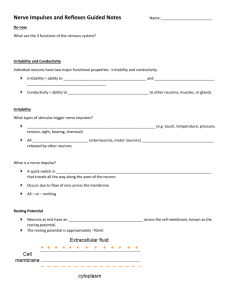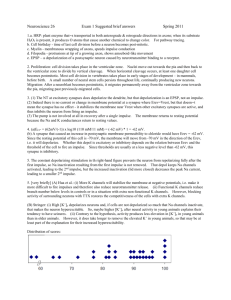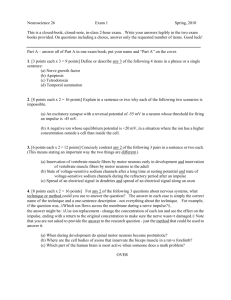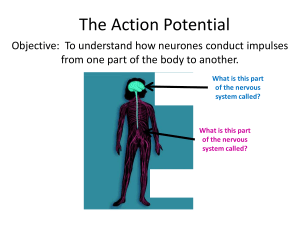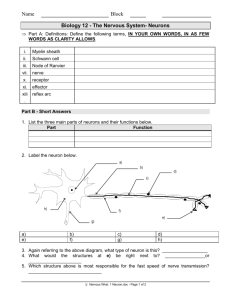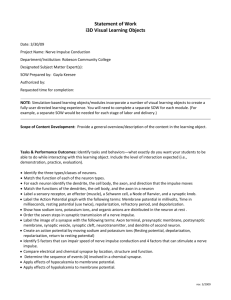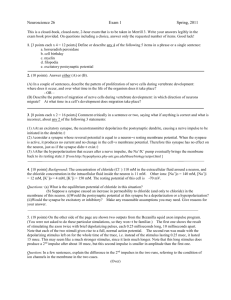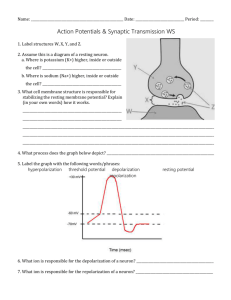AP Biology Nervous System Part 2 Outline
advertisement
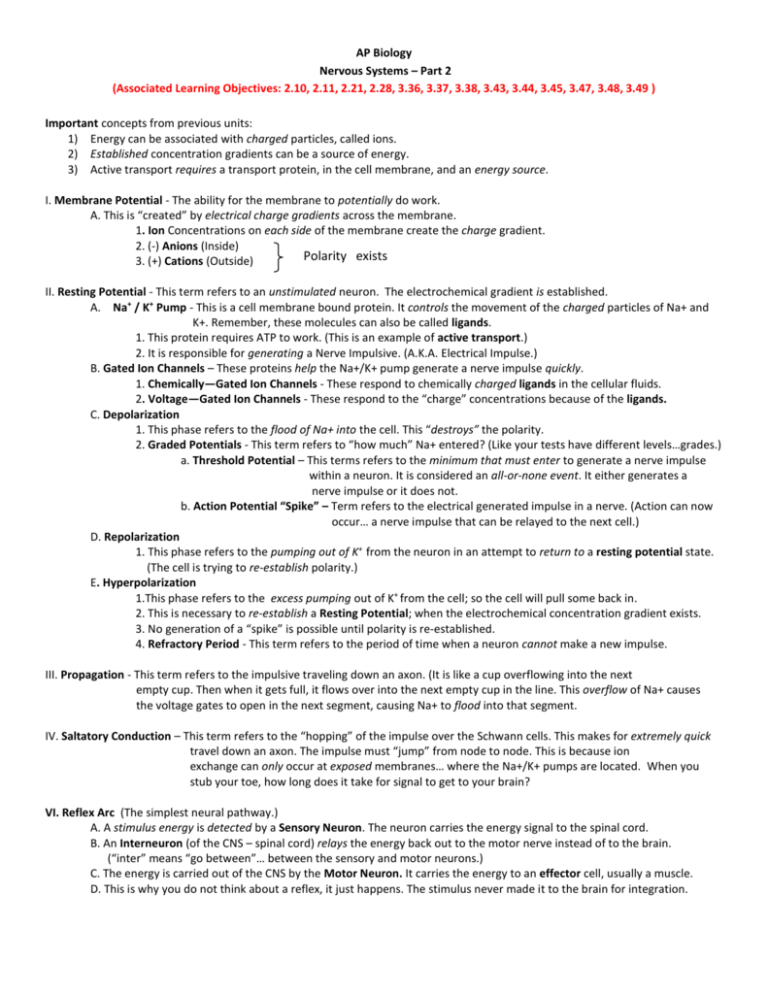
AP Biology Nervous Systems – Part 2 (Associated Learning Objectives: 2.10, 2.11, 2.21, 2.28, 3.36, 3.37, 3.38, 3.43, 3.44, 3.45, 3.47, 3.48, 3.49 ) Important concepts from previous units: 1) Energy can be associated with charged particles, called ions. 2) Established concentration gradients can be a source of energy. 3) Active transport requires a transport protein, in the cell membrane, and an energy source. I. Membrane Potential - The ability for the membrane to potentially do work. A. This is “created” by electrical charge gradients across the membrane. 1. Ion Concentrations on each side of the membrane create the charge gradient. 2. (-) Anions (Inside) Polarity exists 3. (+) Cations (Outside) II. Resting Potential - This term refers to an unstimulated neuron. The electrochemical gradient is established. A. Na+ / K+ Pump - This is a cell membrane bound protein. It controls the movement of the charged particles of Na+ and K+. Remember, these molecules can also be called ligands. 1. This protein requires ATP to work. (This is an example of active transport.) 2. It is responsible for generating a Nerve Impulsive. (A.K.A. Electrical Impulse.) B. Gated Ion Channels – These proteins help the Na+/K+ pump generate a nerve impulse quickly. 1. Chemically—Gated Ion Channels - These respond to chemically charged ligands in the cellular fluids. 2. Voltage—Gated Ion Channels - These respond to the “charge” concentrations because of the ligands. C. Depolarization 1. This phase refers to the flood of Na+ into the cell. This “destroys” the polarity. 2. Graded Potentials - This term refers to “how much” Na+ entered? (Like your tests have different levels…grades.) a. Threshold Potential – This terms refers to the minimum that must enter to generate a nerve impulse within a neuron. It is considered an all-or-none event. It either generates a nerve impulse or it does not. b. Action Potential “Spike” – Term refers to the electrical generated impulse in a nerve. (Action can now occur… a nerve impulse that can be relayed to the next cell.) D. Repolarization 1. This phase refers to the pumping out of K+ from the neuron in an attempt to return to a resting potential state. (The cell is trying to re-establish polarity.) E. Hyperpolarization 1.This phase refers to the excess pumping out of K+ from the cell; so the cell will pull some back in. 2. This is necessary to re-establish a Resting Potential; when the electrochemical concentration gradient exists. 3. No generation of a “spike” is possible until polarity is re-established. 4. Refractory Period - This term refers to the period of time when a neuron cannot make a new impulse. III. Propagation - This term refers to the impulsive traveling down an axon. (It is like a cup overflowing into the next empty cup. Then when it gets full, it flows over into the next empty cup in the line. This overflow of Na+ causes the voltage gates to open in the next segment, causing Na+ to flood into that segment. IV. Saltatory Conduction – This term refers to the “hopping” of the impulse over the Schwann cells. This makes for extremely quick travel down an axon. The impulse must “jump” from node to node. This is because ion exchange can only occur at exposed membranes… where the Na+/K+ pumps are located. When you stub your toe, how long does it take for signal to get to your brain? VI. Reflex Arc (The simplest neural pathway.) A. A stimulus energy is detected by a Sensory Neuron. The neuron carries the energy signal to the spinal cord. B. An Interneuron (of the CNS – spinal cord) relays the energy back out to the motor nerve instead of to the brain. (“inter” means “go between”… between the sensory and motor neurons.) C. The energy is carried out of the CNS by the Motor Neuron. It carries the energy to an effector cell, usually a muscle. D. This is why you do not think about a reflex, it just happens. The stimulus never made it to the brain for integration.

